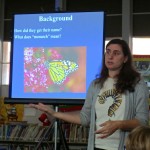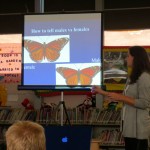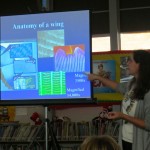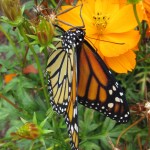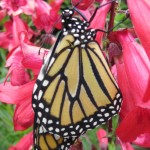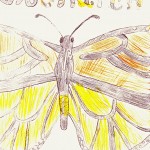
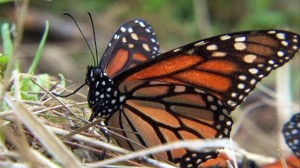 Santa Margarita School LATO Lunch Club members enjoyed learning about monarch butterfly biology and ecology during our February 25 meeting at the school library. Project Monarch Alert Coordinator and Cal Poly Biological Sciences graduate student Jessica Griffiths is an excellent teacher!
Santa Margarita School LATO Lunch Club members enjoyed learning about monarch butterfly biology and ecology during our February 25 meeting at the school library. Project Monarch Alert Coordinator and Cal Poly Biological Sciences graduate student Jessica Griffiths is an excellent teacher!
Oak Ambassador Captain Sammi has provided a great report. See if you can answer the questions below. If you need help, read Sammi’s report posted below and then try again!
[toggle title=”What is the origin of this butterfly’s common name?”] The Monarch butterfly was named in honor of King William III of England. [/toggle]
[toggle title=”What do you call a butterfly’s pupal case?”] A chrysalis. A moth pupates within a cocoon. [/toggle]
[toggle title=”Why do monarch caterpillars and butterflies taste gross to most animals who try to eat them?”]Monarch caterpillars eat milkweed plants. Milkweed sap contains a cardiac glycoside toxin that monarchs, and some other insects, are immune to. This toxin give the monarchs a terrible taste which potential predators learn to avoid. The bad taste is associated with the bright orange and black patterned wings. [/toggle]
[toggle title=”What do you call monarch (insect) blood?”]It is called hemolymph. This circulatory fluid is functionally similar to human blood in that it carries nutrients, waste and oxygen throughout the insect’s body.[/toggle]
[toggle title=”Why is milkweed so important to monarch butterflies?”] Monarch’s require milkweed as the host plant for growing caterpillars.[/toggle]
[toggle title=”How do monarch butterflies find their way to overwintering sites?”] Monarchs use the sun and an internal clock to guide their migration. Monarch populations West of the Rockies migrate to coastal California during the winter while populations East of the Rockies migrate to sites in Mexico. On the Central Coast, massive aggregations of adult monarch butterflies find winter shelter within the canopies of eucalyptus, pine and redwood trees.[/toggle]
Read Sammi’s report: Monarch Butterflies
- Monthly science and nature presentations in the library for 4th-6th graders at Santa Margarita School.
- How can you tell the difference between a male and a female monarch?
- Amazing migration!
- Wings have scales for protection.
- Butterfly scientist Jessica with young scientist-in-training Sammi
- Empty chrysalis
- Trying out new wings
- Enjoying first steps
- Male or female?
- Winged beauty
- Thank you, Jessica Griffiths!


